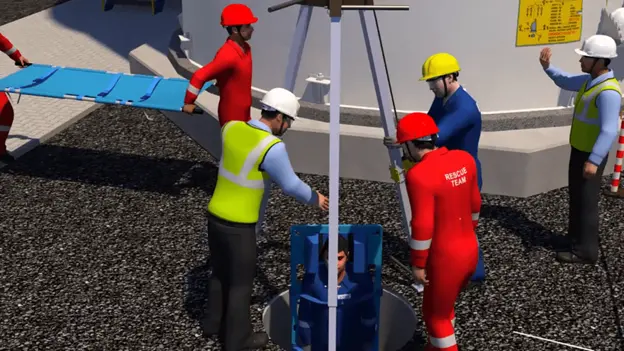Table of Contents
- Introduction
- Confined Space Hazards: Hazards of Working in Confined Spaces
- Low Oxygen Levels: A Critical Confined Space Hazard
- Vapors, Fumes, and Gases: Hazards from Confined Space Environments
- Flooding: Potential Risks of Confined Space Flooding
- Dust
- Explosions and Fires
- Thermostat
- Access Limitations: Challenges in Confined Space Entry and Exit
- Steps To Be Taken For Safe Working In Confined Spaces
- Barriers
- Lanyards
- Conclusion
Introduction
Safety in confined spaces goes beyond mere regulatory compliance—it's about saving lives. Regularly reviewing and updating safety protocols, combined with ongoing education, ensures that every worker returns home safely.
Have you ever overlooked a critical hazard when preparing for work in confined spaces? Which one do you think is most frequently forgotten? Why are confined spaces so dangerous?
If you ask many employees, managers, and health and safety advisers, they might say that explosions and dangerous gases are the only threats in confined spaces. However, those familiar with the Confined Space Regulations 1997 will point out that drowning and severe increases in body temperature are also significant risks.
One hazard that is often overlooked is falling and falling objects.
If you’re falling headfirst down a pitch-black hole in the ground, wearing steel-toe cap boots and a high-visibility vest won’t do much good.
How often have you seen someone open a manhole cover and then bend over to see what's inside, without any safety precautions? Even if they are monitoring gas levels, they could still fall in. It's not uncommon to see a health and safety manager or trainer standing next to an open cover or hatch with a significant drop below, discussing other dangers while neglecting the immediate risk of falling.
There are seven main hazards that make confined spaces dangerous. If working in confined spaces is unavoidable, utmost caution is required. Practical and virtual training, such as safety animations and eLearning, alongside thorough confined space risk assessments, can enhance workers' safety awareness.
Confined Space Hazards: Hazards of Working in Confined Spaces
1. Low Oxygen Levels: A Critical Confined Space Hazard

Section Subtitle
Write one or two paragraphs describing your product or services. To be successful your content needs to be useful to your readers.
Start with the customer – find out what they want and give it to them.
2. Vapors, Fumes, and Gases: Hazards from Confined Space Environments
Poor ventilation in confined spaces can lead to the accumulation of toxic vapors and gases. These can originate from polluted land, burst gas pipes, or activities like welding and painting. Without proper extraction or ventilation, these gases and vapors can create a hazardous atmosphere.
3. Flooding: Potential Risks of Confined Space Flooding
Liquids can quickly fill confined spaces, especially in drainage or sewer operations, posing a drowning risk. Solids, such as collapsing trenches, can also fill confined spaces, trapping or burying workers. Flooding in confined spaces can occur rapidly, leaving little time for escape.
4. Dust
Dust can accumulate in confined spaces naturally or from activities like drilling or grinding. Inhaling excessive dust can cause lung issues, and hazardous dust can be fatal. Additionally, dust accumulation increases the risk of fire or explosion in poorly ventilated areas.
5. Explosions and Fires
The presence of flammable dust, liquids, gases, and vapors in confined spaces heightens the risk of fires and explosions. Hot work or items that can spark also increase these risks. Both too little and too much oxygen can be dangerous, with high oxygen levels raising the risk of fire and explosion.
6. Thermostat
High temperatures from strenuous work, hot environments, or natural heat can be hazardous in confined spaces. Heat can quickly accumulate, leading to heatstroke, exhaustion, and collapse, especially in areas that are difficult to escape.
7. Access Limitations: Challenges in Confined Space Entry and Exit
Confined spaces are often hard to enter and exit, complicating emergency rescues. Once inside, escaping can be difficult or impossible. Ensuring safe working conditions before entry and having emergency plans in place is crucial.
If working in confined spaces is unavoidable, a thorough risk assessment is essential to identify dangers and necessary safety measures.
Steps To Be Taken For Safe Working In Confined Spaces
1. Barriers
Barriers prevent workers at ground level from falling into confined spaces. Some barriers include gates that allow workers to attach to a fall arrest device before entering. Barriers offer collective protection, safeguarding everyone near the confined area with minimal training required.
2. Lanyards
Personal protection devices like fall arrest lanyards or adjustable lanyards offer versatile protection, allowing use of the tripod while protecting one person at a time. Though barriers are generally preferred for collective protection, lanyards provide more space for emergency rescues.
Conclusion
Understanding confined space hazards is vital for worker safety. The seven hazards discussed—low oxygen levels, toxic atmospheres, flammable gases, entrapment, engulfment, physical obstacles, and limited ventilation—each pose unique risks that can lead to severe injuries or fatalities if not properly managed.
Employers and workers must prioritize safety measures, including comprehensive training, rigorous hazard assessments, and appropriate safety equipment. By fostering a culture of safety and vigilance, the risks associated with confined spaces can be significantly reduced.
Stay informed, stay prepared, and most importantly, stay safe. For more information on safety training, visit the Core EHS homepage.